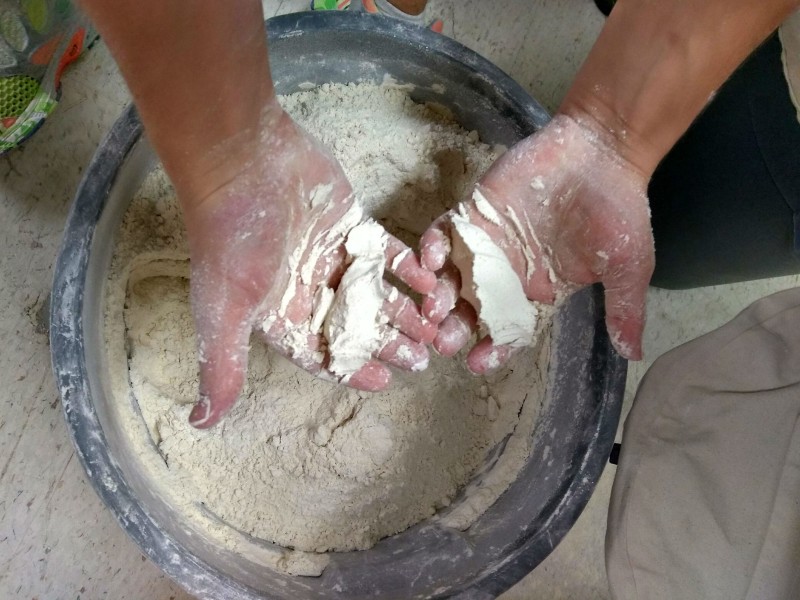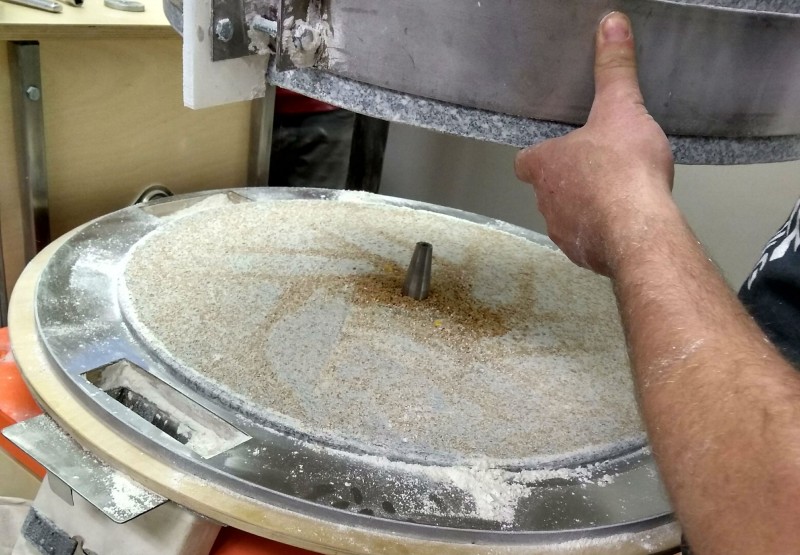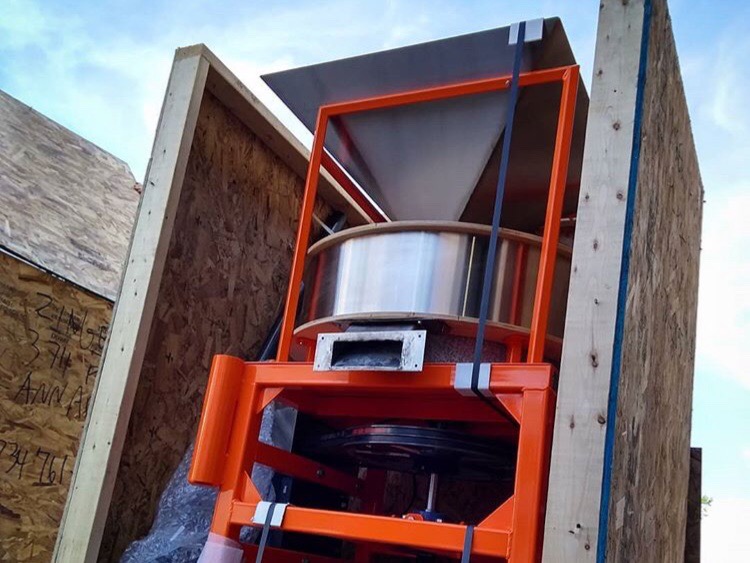Stone milling fresh flour from grains grown locally has a rich and storied history throughout southeastern Michigan and especially here in Ann Arbor and greater Washtenaw County. This history goes as far back as the early 19th century, during the earliest days of settlement of what was then the Michigan “frontier;” a time when water-powered stone grist mills were at the heart of every town and agricultural community that settled along the Huron, Clinton, and Raisin Rivers and their tributaries throughout Washtenaw County.

Damming streams and building water-powered sawmills and stone grist mills were among the most important tasks in any frontier settlement bolstered by agriculture. Many of the folks who came to settle Washtenaw County in the 1820s and 1830s were seasoned grain farmers and millwrights from the bread basket and wheat-growing regions of New York and New England, their arrival facilitated by the opening of the Erie Canal. Beckoning them to the area, apart from their pioneering spirit, was the Huron River, with its myriad tributaries, and its fertile valley, which became by the mid 19th century one of the most productive wheat-growing regions in the country.
The Huron River, with its steep gradient of 200 feet from Portage Lake to Rawsonville, and 42 feet within the city of Ann Arbor, proved a highly advantageous source of water power that millwrights were quick to harness, building saw mills and stone grist flouring mills all along its banks, just as the surrounding valley was being deforested and cleared for agriculture.

Neighboring tributaries, including Allen’s Creek, Fleming Creek, Traver Creek, and Mill Creek, were also utilized as power sources. By the mid 19th century, water-powered grist, saw, woolen, paper, pulp, plaster, and cider mills occupied more than 50 sites along the Huron and its tributaries throughout Washtenaw County. Indeed, so many mills were built along the western reaches of the Huron, Clinton, and Raisin at this time that the area was called the “power belt.” Within the first five years of county settlement, Ann Arbor, alone, was home to a number of saw and stone grist mills:
-
In the summer of 1824, Robert Fleming built a saw mill on Sec. 25 (north of Huron River at Gettysburg). Today this is just east of the intersection of Dixboro and Geddes Roads on Fleming Creek. In 1826, John Dix’s stone grist mill joined the saw mill on Fleming Creek.
-
John Geddes and his brother, Robert, constructed a saw mill almost directly across the river from the Fleming Mill, commencing operations in March 1829. It was around the Geddes mill that a small area settlement gradually coalesced.
-
In 1825 Andrew Newland built Ann Arbor’s first saw mill at the north end of N. State Street. The race for this mill—that is, the narrow channel constructed off the dam or mill pond to funnel a swift and powerful current of water to the mill’s power-generating water wheel—was on the south side of the river and must have come from the Allen’s Creek mill race.
-
In August of 1826, George W. Noyes built a grist mill on N. Main Street, run by water from Allen’s Creek.
-
During 1829-30, Anson Brown built the flouring mill of Swift and Co. and the dam and mill race at Argo to power it.
-
Ann Arbor’s co-founder, John Allen, dammed his namesake creek just south of Huron St.; the mill race ran west of the creek down to just below Argo Dam, where it powered the City Mill, a flour mill a little north of the corner of Main and Depot;
-
Later, in 1873, William Q. Parker built a grist mill over the foundation of the old Fleming saw mill on Fleming Creek, which had since gone to ruin, to produce corn feed for his adjacent 61-acre family farm (between Geddes Road and the Huron River). In 1910, after William’s death, his son George took over the operation of the stone grist mill, expanding it to a commercial flour mill which sold pancake mix, graham flour, buckwheat flour, cornmeal, and cracked wheat breakfast cereal to area stores, up until 1959, when it ceased commercial operations following George’s death. Still standing today and fully operational, the Parker Mill is a well-preserved example of the small-scale, family-run, combination farm-and-grist-mill operation that was so prevalent in the county and across southeastern Michigan in the 19th century.

Along with Ann Arbor, Ypsilanti became another major milling hub for the county, likewise beginning in the 1820s, when the area was first being settled. By the 1840s, the town saw the construction of at least six flour mills on the Huron River:
-
Woodruff’s Flour Mill – Constructed in 1824-1825, south of Ypsilanti, by Major Benjamin Woodruff, the mill was in operation until 1839. No dam was constructed as the mill was sufficiently powered by a natural waterfall of 11 feet, which was claimed to be the third best power on the Huron.
-
Hardy & Reading’s Saw Mill and Flouring Mill – The first mill-dam in Ypsilanti was that of Hardy & Reading, built in 1827 at the corner of French Claim 691 and the southwest quarter of section 4 of Ypsilanti Township. The dam, made of brush, clay, and logs, was more likely the work of the “beaver tribe,” than of “enterprising men,” as one local historian noted in the 1880s. The dam washed away in the flood of 1832, with the woolen mill’s dam located at that point later on. While the mill first built at this site was a saw mill, Hardy & Reading also built a flouring mill nearby in 1828; that mill burned in 1851.
-
Harwood’s Flouring Mill – Ypsilanti’s third flouring mill was constructed in 1829, by W. W. Harwood, just south of Congress Street, on the left bank of the Huron. By 1888, ownership of the mill had changed many times and was renamed the Huron Flouring Mill by the Deubel Brothers. (The Deubel Brothers are likely the same Deubels who owned the Swift Deubel & Co. mill in Ann Arbor in 1872.) The mill had also been modernized, sporting “six run of stone, turbine water wheels, and all modern improvements,” producing 15,000 barrels of flour annually for the Detroit and Eastern markets, and grinding another 24,000 bushels of grain for local patrons. The mill, in 1888, was valued at $20,000.
-
Eagle Flouring Mill – In 1839-40, Arden H. Ballard purchased the site of Hardy & Reading’s Saw Mill, along with water rights, and constructed a flour mill at that location. Later owners of this mill included Dr. Clarke of Detroit, 1843; Thomas O. Hill, 1848; Mark Norris and Benjamin Follett, 1850; and Lyman D. Norris and Chauncey Joslin, 1853. In January of 1856, Joslin bought out Norris, becoming the sole proprietor of the Eagle Mill, as well as the Ypsilanti Flouring Mill. In October of 1856, the Eagle Mill burned, apparently after a shipping mishap by the Michigan Central Railroad, which delivered a 30-day backlog of grist to the mill in only 3 days. The fire cost Joslin over $10,000.
-
Ypsilanti Flouring Mill – Built in 1839-40 by Mark Norris, the mill possibly occupied a site at the opposite end of the dam used by the Eagle.
-
AEtna Mills – At some point in the 1840s, Timothy Showerman purchased Hurd & Sage’s Iron Foundry and converted it into a flouring mill. Hurd & Sage had leased a quantity of water power from Mark Norris, but Showerman utilized additional power, resulting in legal proceedings and the stoppage of AEtna. As a result, the mill came to be owned by Norris & Joslin, who converted it into a sash, door, and blind factory, later adding a planing mill, ax-handle factory, and gypsum mill, before the June 1858 floods on the Huron washed the entire operation downstream, at a loss of $12,000.
As is evident from the stories of these local mills, the milling business was not an entirely safe enterprise. Mills during the 1800s faced two major challenges: fires and floods. If they were not destroyed by one they were destroyed by the other. Flour dust from stone grist milling was highly combustible and could ignite and explode when exposed to flame and/or excessive heat. Flooding along the Huron and its tributaries wreaked havoc on the mills’ hydropower system, washing out dams and destroying the mill races, water wheels, and turbines that powered all the milling machinery, including the all-important millstones.

Is stone milling the most efficient way to grind flour? No, but it feeds our soul and hearts by connecting us to our history when it was the primary mode of milling grain in southeastern Michigan.
And have we mentioned the flavor and nutritional benefits? Okay, we have, but it bears repeating. When grain is ground between two millstones, the whole seed kernel—its exterior bran, starchy endosperm, and oily germ, the grain’s nutritional powerhouse—is crushed and combined to create flour that is not only rich in fiber, omega 3s, and nutrients, but is also intensely flavorful.
From Lee Vedder & the Bakehouse Grain Commission
Check out our Special Events line-up for further local and historical learnings, like Jae Gerhart’s discussion about what the growing market for local food looks like in Washtenaw County and the surrounding foodshed, and Dr. Maria Trumpler’s talk about why women stopped baking bread at home (and why it matters).
After a long, established career as a Ph.D. art history scholar and art museum curator, Lee, a Michigan native, came to the Bakehouse in 2017 eager to pursue her passion for artisanal baking and to apply her love of history, research, writing, and editing in a new exciting arena. Her first turn at the Bakehouse was as a day pastry baker. She then moved on to retail sales in the Bakeshop, followed by joining the Marketing Team and becoming the Bakehouse’s designated culinary historian. In addition to her retail sales and marketing work, she’s a member of the Bakehouse’s Grain Commission, co-author and editor of the Bakehouse's series of cookbooklets, and a regular contributor to the BAKE! Blog and Zingerman’s Newsletter, where she explores the culinary, cultural, and social history and evolution of the Bakehouse’s artisan baked goods.



What a lovely article! Rooting around on the web while working on an YpsiStories podcast episode on the nineteenth century milling business I found this article – very accurate and well-written!
Hi Jerome, Many thanks for your comment. I would love to hear more about your podcast episode–perhaps we could compare notes!–and also when it will air. There are two other pieces to my series on local milling history on the Bakehouse blog that may interest you: “Early Mill Design and Their Role in Local Communities,” and “Stone Milling Idioms (We say them all the time!).” I would also point you to the Parker Mill in Ann Arbor off of Geddes Rd. and Sharon Mill off of Sharon Hollow Rd in Manchester for two well-preserved examples of the small-scale 19th-century grist… Read more »